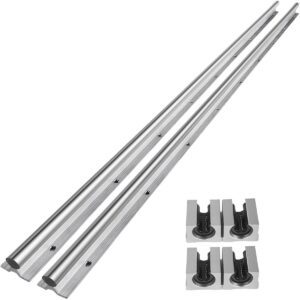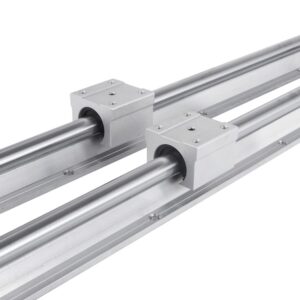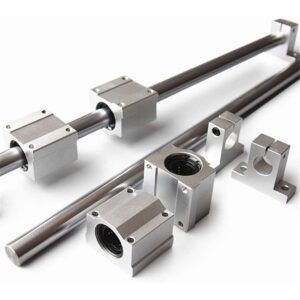Outline for “Linear Way”
| Main Headings | Sub-Headings |
|---|---|
| Introduction to Linear Way | Why Linear Ways Matter in Modern Engineering |
| Linear Way | Definition and Core Concept |
| How a Linear Way Works | Rail, Block, Rolling Elements, Friction Control |
| Types of Linear Way Systems | Linear Ball Guides, Linear Roller Guides, Linear Plain Guides |
| Key Components of Linear Way | Rails, Blocks, Bearings, End Caps, Seals |
| Advantages of Linear Way | Accuracy, Load Capacity, Smooth Motion, Energy Efficiency |
| Challenges of Linear Way | Costs, Installation, Maintenance, Environment Sensitivity |
| Applications of Linear Way | CNC, Robotics, Aerospace, Healthcare, Semiconductor, Packaging |
| Installation of Linear Way | Surface Prep, Rail Mounting, Alignment, Preload Adjustment |
| Maintenance of Linear Way | Lubrication, Cleaning, Wear Detection |
| Linear Way vs Other Motion Systems | Comparison with Shafts, Plain Slides, Linear Actuators |
| Latest Innovations in Linear Way | Self-Lubrication, AI Sensors, Noise Reduction |
| Choosing the Right Linear Way | Load, Speed, Precision, Environment |
| Top Manufacturers of Linear Way | Hiwin, THK, NSK, Bosch Rexroth, IKO |
| Case Studies of Linear Way in Action | CNC, Robotics, Medical Imaging |
| Future of Linear Way | IoT Integration, Predictive Maintenance, Sustainability |
| Cost and ROI Analysis of Linear Way | Investment vs Long-Term Benefits |
| Safety Considerations for Linear Way | Load Limits, Alignment, Emergency Stops |
| Frequently Asked Questions | Six FAQs with Answers |
| Conclusion | Final Thoughts on Linear Way Technology |
Introduction to Linear Way
In precision-driven industries, movement isn’t just about getting from one point to another—it’s about doing so with accuracy, repeatability, and minimal resistance. This is where the linear way system shines.
A linear way is the backbone of CNC machines, robotics, and medical devices. It ensures smooth, friction-free travel along a defined path, enabling components to perform with micron-level accuracy. Without it, modern automation would struggle to achieve the speed and precision it demands.

Linear Way
At its core, a linear way is a mechanical system that allows smooth, controlled movement in a straight line. It typically consists of a rail and a block (or carriage) that contains rolling elements like balls or rollers. These rolling elements reduce friction and allow for high precision and load-bearing capacity.
Linear ways are distinct from simple sliding mechanisms because they are designed to carry both high loads and maintain accuracy across long lifetimes.
How a Linear Way Works
A linear way functions by combining:
Rail: A hardened steel or alloy track.
Block (Carriage): Slides along the rail while carrying the load.
Rolling Elements: Recirculating balls or rollers reduce friction.
Friction Control: The system ensures minimal resistance, allowing smoother travel.
As the block moves along the rail, the rolling elements continuously circulate, reducing wear and extending the system’s life.
Types of Linear Way Systems
Different linear ways exist for different applications:
Linear Ball Guides: Use rolling balls; high precision, low friction.
Linear Roller Guides: Use cylindrical rollers; handle heavier loads.
Linear Plain Guides: No rolling elements; better for dirty or high-impact environments.
The choice depends on whether speed, load, or durability is the top priority.
Key Components of Linear Way
A linear way typically consists of:
Rails – Provide the guiding path.
Blocks – Support loads and house bearings.
Bearings – Reduce friction during movement.
End Caps – Ensure smooth ball or roller circulation.
Seals – Protect against dust, dirt, and contaminants.
Each part is engineered to deliver long-lasting performance.
Advantages of Linear Way
Why are linear ways the gold standard?
High Accuracy – Precision movement with minimal deviation.
Load Capacity – Handles both radial and axial forces.
Smooth Motion – Low friction ensures consistent performance.
Durability – Hardened surfaces withstand wear.
Energy Efficiency – Less energy wasted overcoming resistance.
Versatility – Works across industries and applications.
Challenges of Linear Way
However, they aren’t without drawbacks:
High Cost – More expensive than simple guides.
Complex Installation – Requires skilled alignment.
Maintenance Needs – Lubrication and cleaning are essential.
Environmental Sensitivity – Dust and vibration can affect performance.
Still, when precision is critical, the benefits far outweigh these challenges.
Applications of Linear Way
Linear ways drive performance across industries:
CNC Machines: Provide rigid, vibration-free cutting.
Robotics: Enable precise, repeatable arm movements.
Aerospace: Handle heavy loads with stability.
Healthcare: Used in surgical robots and imaging systems.
Semiconductors: Allow micron-level positioning for chip manufacturing.
Packaging: Increase accuracy and speed in production lines.
Installation of Linear Way
Steps for proper installation include:
Surface Preparation – Ensure flatness and cleanliness.
Rail Mounting – Secure the rail with bolts.
Alignment – Use precision tools to ensure straightness.
Preload Adjustment – Adjust carriage fit for accuracy and rigidity.
Proper installation ensures longer system life and smoother performance.
Maintenance of Linear Way
Keeping systems healthy requires:
Lubrication: Apply grease or oil regularly.
Cleaning: Remove dust, coolant, and debris.
Wear Detection: Check seals, blocks, and rails for early signs of failure.
Monitoring: Use smart sensors in advanced setups.
Linear Way vs Other Motion Systems
Compared to alternatives:
Shaft Systems – Less rigid, cheaper but less accurate.
Plain Slides – Higher friction, lower lifespan.
Linear Actuators – More complex and costly.
Linear ways stand out for their balance of accuracy, strength, and longevity.
Latest Innovations in Linear Way
Recent developments include:
Self-Lubrication Systems: Reduce downtime.
AI-Powered Sensors: Monitor wear and optimize usage.
Noise Reduction Designs: Ideal for labs and medical devices.
Corrosion-Resistant Materials: Extend life in harsh environments.
Choosing the Right Linear Way
Consider the following:
Load Requirements – Heavy loads may require roller guides.
Precision Needs – Ball guides for ultra-precise tasks.
Operating Speed – High-speed systems need smooth rolling guides.
Environment – Sealed or coated systems for dusty/wet conditions.
Budget – Weigh initial cost vs long-term ROI.
Top Manufacturers of Linear Way
Industry leaders include:
Hiwin – Affordable, widely used globally.
THK – Innovators in linear motion technology.
NSK – Strong in heavy-duty applications.
Bosch Rexroth – Specialists in automation.
IKO – Precision Japanese engineering.
Case Studies of Linear Way in Action
CNC Machining: Aerospace firms increased efficiency by 25% using roller guides.
Robotics: Semiconductor plants achieved micron-level accuracy.
Medical Imaging: MRI machines achieved smoother patient positioning.
Future of Linear Way
Trends shaping the future:
IoT Integration – Smart guides for predictive maintenance.
Eco-Friendly Materials – Sustainable alloys and coatings.
AI Motion Optimization – Intelligent control for adaptive performance.
Cost and ROI Analysis of Linear Way
Upfront Costs: Higher than basic guides.
Operational Savings: Reduced wear, downtime, and power consumption.
ROI Timeline: Typically recouped within 2–4 years.
Safety Considerations for Linear Way
Safety tips include:
Load Limits: Avoid exceeding rated capacity.
Alignment Checks: Prevent wear and accidents.
Emergency Stops: Critical for high-speed setups.
Protective Covers: Keep out contaminants.
Frequently Asked Questions
What is a linear way?
It is a rail-and-block system that enables smooth, precise linear motion.
What types of linear ways exist?
Ball guides, roller guides, and plain guides.
Do linear ways need lubrication?
Yes, lubrication is crucial to reduce wear.
Can linear ways handle heavy loads?
Yes, especially roller-based systems.
Are linear ways expensive?
They cost more upfront but save money in efficiency and durability.
Where are linear ways used?
In CNC, robotics, aerospace, healthcare, packaging, and semiconductors.
Conclusion
The linear way system is the backbone of modern automation. By enabling smooth, precise, and durable linear motion, it empowers industries from aerospace to healthcare.
Although the upfront investment is higher than alternatives, the long-term benefits—accuracy, efficiency, and reliability—make it essential in high-value industries. With innovations like AI monitoring and eco-friendly materials, linear ways are set to play an even greater role in the future of precision engineering.
Inbound Link Suggestions
Article on Linear Bearing and Rail for deeper technical insights.
Post on Linear Guide with Motor for integrated automation solutions.



